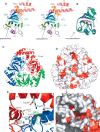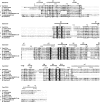Crystal structure of yeast YER010Cp, a knotable member of the RraA protein family
- PMID: 16195557
- PMCID: PMC2253287
- DOI: 10.1110/ps.051684005
Crystal structure of yeast YER010Cp, a knotable member of the RraA protein family
Abstract
We present here the structure of Yer010c protein of unknown function, solved by Multiple Anomalous Diffraction and revealing a common fold and oligomerization state with proteins of the regulator of ribonuclease activity A (RraA) family. In Escherichia coli, RraA has been shown to regulate the activity of ribonuclease E by direct interaction. The absence of ribonuclease E in yeast suggests a different function for this family member in this organism. Yer010cp has a few supplementary secondary structure elements and a deep pseudo-knot at the heart of the protein core. A tunnel at the interface between two monomers, lined with conserved charged residues, has unassigned residual electron density and may constitute an active site for a yet unknown activity.
Figures


Similar articles
-
Crystal structure of Streptomyces coelicolor RraAS2, an unusual member of the RNase E inhibitor RraA protein family.J Microbiol. 2017 May;55(5):388-395. doi: 10.1007/s12275-017-7053-8. Epub 2017 Apr 29. J Microbiol. 2017. PMID: 28455590
-
Biochemical and structural analysis of RraA proteins to decipher their relationships with 4-hydroxy-4-methyl-2-oxoglutarate/4-carboxy-4-hydroxy-2-oxoadipate aldolases.Biochemistry. 2014 Jan 28;53(3):542-53. doi: 10.1021/bi401486g. Epub 2014 Jan 10. Biochemistry. 2014. PMID: 24359411
-
Crystal structure of the YDR533c S. cerevisiae protein, a class II member of the Hsp31 family.Structure. 2004 May;12(5):839-47. doi: 10.1016/j.str.2004.02.030. Structure. 2004. PMID: 15130476
-
The X-ray structure of Escherichia coli RraA (MenG), A protein inhibitor of RNA processing.J Mol Biol. 2003 Oct 3;332(5):1015-24. doi: 10.1016/s0022-2836(03)00970-7. J Mol Biol. 2003. PMID: 14499605
-
Comparison of proteolytic susceptibility in phosphoglycerate kinases from yeast and E. coli: modulation of conformational ensembles without altering structure or stability.J Mol Biol. 2007 May 18;368(5):1438-47. doi: 10.1016/j.jmb.2007.02.077. Epub 2007 Mar 6. J Mol Biol. 2007. PMID: 17397866
Cited by
-
Crystal structure of Streptomyces coelicolor RraAS2, an unusual member of the RNase E inhibitor RraA protein family.J Microbiol. 2017 May;55(5):388-395. doi: 10.1007/s12275-017-7053-8. Epub 2017 Apr 29. J Microbiol. 2017. PMID: 28455590
-
Structural and kinetic characterization of 4-hydroxy-4-methyl-2-oxoglutarate/4-carboxy-4-hydroxy-2-oxoadipate aldolase, a protocatechuate degradation enzyme evolutionarily convergent with the HpaI and DmpG pyruvate aldolases.J Biol Chem. 2010 Nov 19;285(47):36608-15. doi: 10.1074/jbc.M110.159509. Epub 2010 Sep 15. J Biol Chem. 2010. PMID: 20843800 Free PMC article.
References
-
- Bricogne, G., Vonrhein, C., Flensburg, C., Schiltz, M., and Paciorek, W. 2003. Generation, representation and flow of phase information in structure determination: Recent developments in and around SHARP 2.0. Acta Crystallogr. D Biol. Crystallogr. 59 2023–2030. - PubMed
-
- Burley, S.K. and Bonanno, J.B. 2002. Structuring the universe of proteins. Annu. Rev. Genomics Hum. Genet. 3 243–262. - PubMed
-
- Collaborative Computational Project Number 4. 1994. The CCP4 suite: Programs for protein crystallography. Acta Crystallogr. D Biol. Crystallogr. 50 760–763. - PubMed
-
- Chen, L. and Sigler, P.B. 1999. The crystal structure of a GroEL/peptide complex: Plasticity as a basis for substrate diversity. Cell 99 757–768. - PubMed
-
- Glaser, F., Pupko, T., Paz, I., Bell, R.E., Bechor-Shental, D., Martz, E., and Ben-Tal, N. 2003. ConSurf: Identification of functional regions in proteins by surface-mapping of phylogenetic information. Bioinformatics 19 163–164. - PubMed
Publication types
MeSH terms
Substances
LinkOut - more resources
Full Text Sources
Molecular Biology Databases

